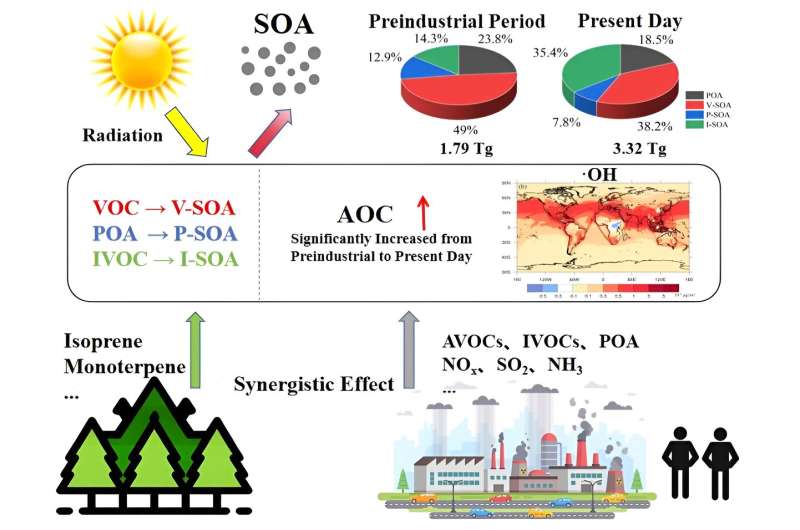This article has been reviewed according to Science X's editorial process and policies. Editors have highlighted the following attributes while ensuring the content's credibility:
fact-checked
peer-reviewed publication
trusted source
proofread
The impact of human activity on air quality: A look at aerosol pollution before and after the Industrial Revolution

A recent study led by the Institute of Atmospheric Physics at the Chinese Academy of Sciences sheds new light on how human activities have altered the composition of the atmosphere over time, particularly focusing on secondary organic aerosols (SOA). These aerosols play a significant role in air quality and climate change, making it crucial to understand their evolution from the preindustrial era to the present day.
The study, published in Advances in Atmospheric Sciences, highlights the need to quantify the differences in SOA levels between the preindustrial period and today to accurately assess the environmental impact of human activities.
SOAs are tiny particles that form in the atmosphere from natural and man-made emissions. They influence both climate and air quality, and their levels have changed dramatically since the Industrial Revolution.
Two major challenges have historically hindered accurate SOA simulations.
"One is missing historical data. There is limited information about vegetation cover during the preindustrial period, making it difficult to estimate natural emissions," explains Dr. Chen Xueshun, one of the corresponding authors. "The other is uncertainties in SOA formation. Understanding how SOAs form is complex, and existing models have struggled to capture this process accurately."
To overcome these obstacles, the research team incorporated advanced tools into their models, including the MEGAN emissions module and the IAP-AACM atmospheric chemistry model. They used a dynamic vegetation model to simulate the natural emissions from plants, allowing for a more accurate comparison of SOA levels between the two periods.
The study found that while natural emissions (biogenic SOAs) dominated in the preindustrial atmosphere, human-made SOAs have surged since the Industrial Revolution. Today, anthropogenic SOAs contribute up to 53% of total SOA levels, a significant increase from preindustrial times.
"In the preindustrial period, natural sources were the primary contributors to SOA. However, our findings show that human activities have greatly amplified SOA production in the present day, leading to significant changes in global air quality," explained Dr. Chen.
Looking ahead, the research team plans to delve deeper into the climate impacts of these aerosols. "Our next step is to quantify the climate effects of organic aerosols and explore the interactions between vegetation, air quality, and climate," said Prof. Wang Zifa, also the corresponding author of the study. "This will help us better understand the full scope of human impact on the environment."
More information: Yingchuan Yang et al, Contrast in Secondary Organic Aerosols between the Present Day and the Preindustrial Period: The Importance of Nontraditional Sources and the Changed Atmospheric Oxidation Capability, Advances in Atmospheric Sciences (2024). DOI: 10.1007/s00376-024-3281-0
Journal information: Advances in Atmospheric Sciences
Provided by Chinese Academy of Sciences




















